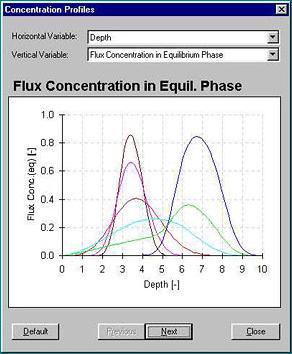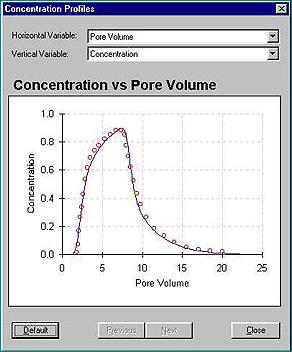| STANMOD Model |

|
| The program and manual can be downloaded from the software download area or from the HYDRUS-2D web site. |
Evaluating Solute Transport in Porous Media Using
|
J. Simunek, M.Th. van Genuchten, M. Sejna, N. Toride, and F. J. Leij
|
| STANMOD (STudio of ANalytical MODels) is a Windows based computer software package for evaluating solute transport in porous media using analytical solutions of the convection-dispersion solute transport equation. Version 1.0 of STANMOD includes the following models for one-dimensional transport problems:
|
  |
examples included |
CXTFITThe software package includes a modified and updated version of the CXTFIT code of Toride et al.[1995] for estimating solute transport parameters using a nonlinear least-squares parameter optimization method. This code may be used to solve the inverse problem by fitting a variety of analytical solutions of theoretical transport models, based upon the one-dimensional convection-dispersion equation (CDE), to experimental results. The program may also be used to solve the direct or forward problem to determine concentrations as a function of time and/or position. Three different one-dimensional transport models are considered: (i) the conventional equilibrium CDE; (ii) the chemical and physical nonequilibrium CDEs; and (iii) a stochastic stream tube model based upon the local-scale equilibrium or nonequilibrium CDE. |
top of page |
 |
CFITMSTANMOD also comes with an updated version of the CFITM code of van Genuchten [1980] for analyzing observed column effluent data using analytical solutions of the one-dimensional equilibrium convective-dispersive transport equations. The code considers analytical solutions for both semi-finite and finite columns. The model provides an easy to use, efficient and accurate means of determining various transport parameters by optimizing observed column effluent data. CFITM represents a simple alternative to the much more comprehensive, but also more complex, CXTFIT model. |
top of page |
CFITIMSTANMOD also contains an updated version of the CFITIM code of van Genuchten [1981] for analyzing observed column effluent data using analytical solutions of the one-dimensional equilibrium and nonequilibriumconvective-dispersive transport equations. The code involves analytical solutions for semi-finite columns. The nonequilibrium solutions consider the two-region dual-porosity (bi-continuum) flow model for physical nonequilibrium and the one-site or two-site sorption models for chemical nonequilibrium. The model provides an easy to use, efficient and accurate means of determining various transport parameters by optimizing column effluent data. |
top of page |
CHAINIn addition, STANMOD 1.0 includes the modified and updated CHAIN code of van Genuchten [1985] for analyzing the convective-dispersive transport of solutes involved in sequential first-order decay reactions. Examples are the migration of radionuclides in which the chain members form first-order decay reactions, and the simultaneous movement of various interacting nitrogen or organic species. |
top of page |
3DADESTANMOD 2.0 will include the 3DADE code of Leij and Bradford [1994] for evaluating analytical solutions for two- and three-dimensional equilibrium solute transport in the subsurface. The analytical solutions assume steady unidirectional water flow in porous media having uniform flow and transport properties. The transport equation contains terms accounting for solute movement by convection and dispersion, as well as for solute retardation, first-order decay, and zero-order production. The 3DADE code can be used to solve the direct problem, i.e., the concentration is calculated as a function of time and space for specified model parameters, and the indirect (inverse) problem in which the program estimates selected transport parameters by fitting one of the analytical solutions to specified experimental data. |
top of page |
N3DADEFinally, STANMOD 2.0 will incorporate the N3DADE code of Leij and Toride [1997] for evaluating analytical solutions two- and three-dimensional nonequilibrium solute transport in porous media. The analytical solutions pertain to multi-dimensional solute transport during steady unidirectional water flow in porous media in systems of semi-infinite length in the longitudinal direction, and of infinite length in the transverse direction. The solutions can be applied also to one- and two-dimensional problems. The flow and transport properties of the medium are again assumed to be macroscopically uniform. Nonequilibrium solute transfer can occur between two domains in either the liquid phase (physical nonequilibrium) or the absorbed phase (chemical nonequilibrium). The transport equation contains terms accounting for solute movement by advection and dispersion, as well as for solute retardation, first-order decay, and zero-order production. |
top of page |
System RequirementsIntel Pentium processor, 16 Mb RAM, hard disk with at least 20 Mb free disk space, VGA graphics (SVGA with 256 colors recommended), MS Windows 95 or higher. |
Technical contact: |
|
Todd Skaggs |
